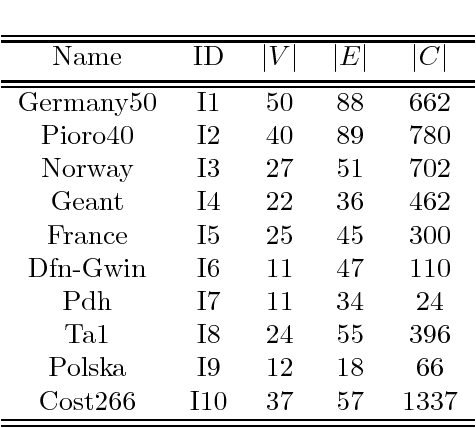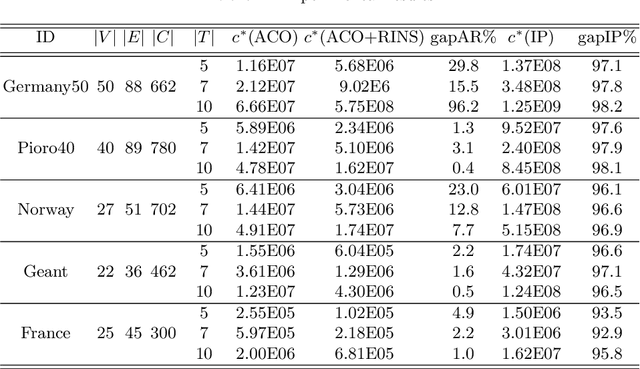Fabio D'Andreagiovanni
An LP-based Primal Heuristic for 3-Architecture Connected Facility Location in Urban Access Network Design
Apr 27, 2017
Abstract:We investigate the 3-architecture Connected Facility Location Problem arising in the design of urban telecommunication access networks. We propose an original optimization model for the problem that includes additional variables and constraints to take into account wireless signal coverage. Since the problem can prove challenging even for modern state-of-the art optimization solvers, we propose to solve it by an original primal heuristic which combines a probabilistic fixing procedure, guided by peculiar Linear Programming relaxations, with an exact MIP heuristic, based on a very large neighborhood search. Computational experiments on a set of realistic instances show that our heuristic can find solutions associated with much lower optimality gaps than a state-of-the-art solver.
A Fast Hybrid Primal Heuristic for Multiband Robust Capacitated Network Design with Multiple Time Periods
Apr 27, 2017

Abstract:We investigate the Robust Multiperiod Network Design Problem, a generalization of the Capacitated Network Design Problem (CNDP) that, besides establishing flow routing and network capacity installation as in a canonical CNDP, also considers a planning horizon made up of multiple time periods and protection against fluctuations in traffic volumes. As a remedy against traffic volume uncertainty, we propose a Robust Optimization model based on Multiband Robustness (B\"using and D'Andreagiovanni, 2012), a refinement of classical Gamma-Robustness by Bertsimas and Sim that uses a system of multiple deviation bands. Since the resulting optimization problem may prove very challenging even for instances of moderate size solved by a state-of-the-art optimization solver, we propose a hybrid primal heuristic that combines a randomized fixing strategy inspired by ant colony optimization, which exploits information coming from linear relaxations of the problem, and an exact large neighbourhood search. Computational experiments on a set of realistic instances from the SNDlib show that our original heuristic can run fast and produce solutions of extremely high quality associated with low optimality gaps.
* This is the authors' final version of the paper published in Applied Soft Computing 26, 497-507, 2015, DOI: 10.1016/j.asoc.2014.10.016. The final publication is available at Elsevier ScienceDirect via http://dx.doi.org/10.1016/j.asoc.2014.10.016
A hybrid primal heuristic for Robust Multiperiod Network Design
Apr 22, 2017
Abstract:We investigate the Robust Multiperiod Network Design Problem, a generalization of the classical Capacitated Network Design Problem that additionally considers multiple design periods and provides solutions protected against traffic uncertainty. Given the intrinsic difficulty of the problem, which proves challenging even for state-of-the art commercial solvers, we propose a hybrid primal heuristic based on the combination of ant colony optimization and an exact large neighborhood search. Computational experiments on a set of realistic instances from the SNDlib show that our heuristic can find solutions of extremely good quality with low optimality gap.
* This is the authors' final version of the paper published in: Esparcia-Alc\'azar A., Mora A. (eds), EvoApplications 2014: Applications of Evolutionary Computation, LNCS 8602, pp. 15-26, 2014. DOI: 10.1007/978-3-662-45523-4\_2. The final publication is available at Springer via http://dx.doi.org/10.1007/978-3-662-45523-4_2. arXiv admin note: substantial text overlap with arXiv:1410.5850
A hybrid exact-ACO algorithm for the joint scheduling, power and cluster assignment in cooperative wireless networks
Apr 21, 2017
Abstract:Base station cooperation (BSC) has recently arisen as a promising way to increase the capacity of a wireless network. Implementing BSC adds a new design dimension to the classical wireless network design problem: how to define the subset of base stations (clusters) that coordinate to serve a user. Though the problem of forming clusters has been extensively discussed from a technical point of view, there is still a lack of effective optimization models for its representation and algorithms for its solution. In this work, we make a further step towards filling such gap: 1) we generalize the classical network design problem by adding cooperation as an additional decision dimension; 2) we develop a strong formulation for the resulting problem; 3) we define a new hybrid solution algorithm that combines exact large neighborhood search and ant colony optimization. Finally, we assess the performance of our new model and algorithm on a set of realistic instances of a WiMAX network.
* This is the author's final version of the paper published in G. Di Caro, G. Theraulaz (eds.), BIONETICS 2012: Bio-Inspired Models of Network, Information, and Computing Systems. LNICST, vol. 134, pp. 3-17. Springer, Heidelberg, 2014, DOI: 10.1007/978-3-319-06944-9_1 ). The final publication is available at Springer via http://dx.doi.org/10.1007/978-3-319-06944-9_1
 Add to Chrome
Add to Chrome Add to Firefox
Add to Firefox Add to Edge
Add to Edge